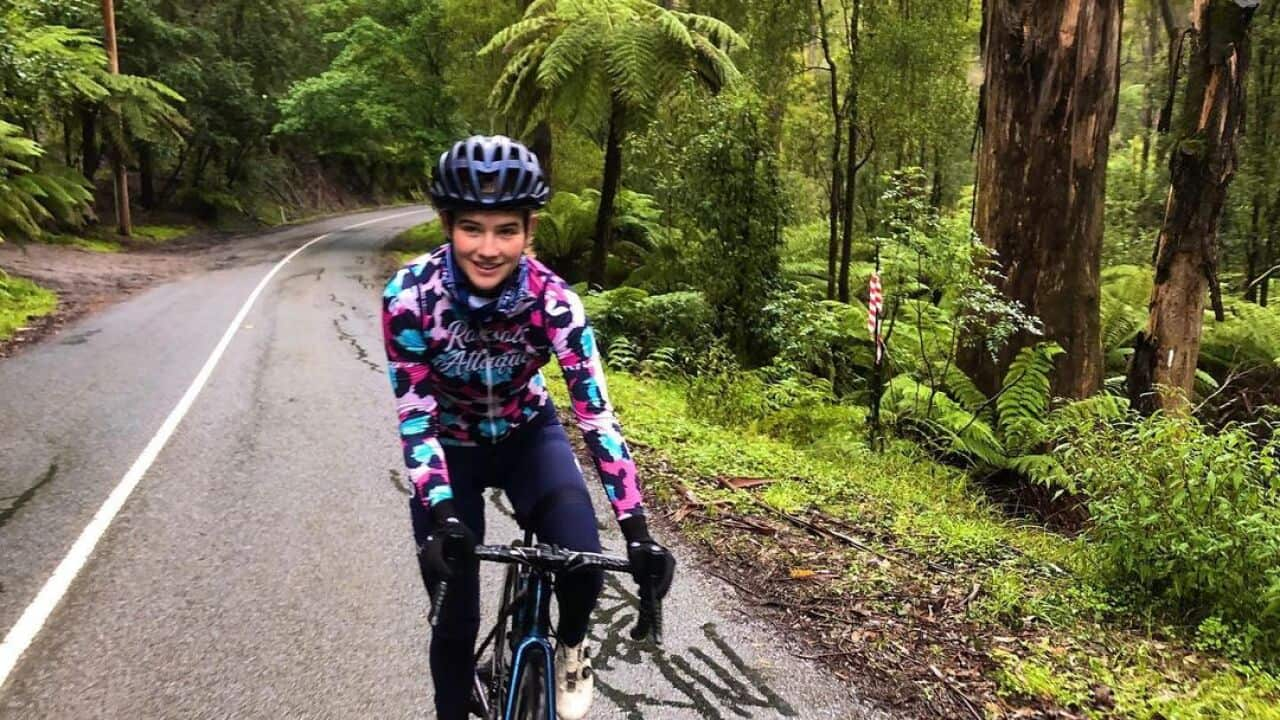The place to watch the Tour de France Femmes is right here on SBS. Replays, mini stage recaps, extended highlights, winning moments and live streaming can be found on the and the SBS Skoda Tour Tracker,available for download on and from August 12 to 18.
Full disclosure: We published this article in the lead-up to the inaugural Tour de France Femmes, but felt it deserved an update in the lead-up to the 2024 edition.

Comprehensively dressed cyclists in Hyde Park, London, in the 1900s Credit: Heritage Images/Getty Images
1. Bicycle Face – a made-up medical condition – was used to frighten women away from cycling
Bicycle Face – simultaneously one of the most hilarious and appalling moments in the history of cycling for women – was a made-up medical condition that doctors warned ladies about in the late 19th century.
Bicycle Face was said to occur as a result of over-exerting oneself while maintaining one’s balance on two-wheeled ma(n)chines. A wide range of symptoms included flushed but pale skin, a wild or weary expression and a dark look under the eyes.
The condition was said to mostly affect women, although some sources suggest that anyone could fall prey to the terrors of Bicycle Face if they weren’t careful.

Step-through frames were seen as more appropriate for women in the 1900s. Credit: Universal History Archive/Universal Images Group via Getty
According to , while the condition was first reported in the 1890s, by the end of the century, “many doctors began to publicly question the idea of Bicycle Face, noting that people concentrate when riding or driving any sort of vehicle without it causing lasting facial damage.”
How’s your Bicycle Face looking lately?
2. Kittie Knox joins the League of American Wheelmen
Fortunately, the severe threats and consequences of Bicycle Face didn’t slow women down as much as some may have hoped. In 1893, Kittie Knox, a seamstress from Boston, made history as the first African American woman accepted into the League of American Wheelmen.
Among many battles Knox faced on and off the bike was the issue of what constituted acceptable attire. She became known as one of the first women to wear men’s bloomers. This marks an important progression toward women having the social freedom to ride and race in shorts today.
3. Cissie Colreavy "mounted the bike, man-fashion" in Australia
While Knox was racing in the United States, the Colreavy family, who owned the Shamrock Hotel in Coolgardie, Australia, used to hold some of Western Australia’s earliest cycling events. Their daughter Cissie caught a terribly contagious case of Bicycle Face (or was it simply the flushed cheeks of pure and joyous Bicycle Love?) and entered the history books as one of Australia’s pioneering female cyclists.
According to , “she became one of the first women in Australia to rock bloomers instead of a dress at races - one newspaper wrote that she ‘mounted the bike, man-fashion'. They did add that after mounting the bike, she 'scorched down Bayley-Street to ringing cheers - and beers'.”

Bloomers and divided skirts were eventually declared a 'rational' costume for female cyclists, as depicted in this 19th-century engraving. This artist's rendering of bicycle wheels appears somewhat less rational. Credit: Universal History Archive/Universal Images Group via Getty
4, 5 and 6. More Australian trailblazers set long-distance records
Amid more medical controversies and social pushback, several Australian riders set new records and standards for what women could achieve in cycling, and how. Women like Lucy Beyer, who cycled from Sydney to Melbourne in eight days in 1896, completing half of the journey in the rain. A week later, C. T. Newton beat Beyer’s record, completing the trip in six days and thirteen hours; a trip which included a 23-hour stint from Gundagai to Albury.
Valda Unthank set a 33-hour and 43-minute cycling record from Adelaide to Melbourne in 1938, breaking the previous best (male) record by over 13 hours. This was one of several ambitious records set by Unthank in the 1930s. For anyone passing through South Gippsland, Victoria, we recommend dropping into the Wonthaggi Railway Station Museum to see her bike, trophies and other memorabilia.
In honour of the many Australian female cycling icons in these early days of the sport, and with respect to the meaning of trailblazer indicating those who not only achieved new things, but really paved the way for others to follow in their tyre tracks, let’s conservatively boost the tally for this article by another 400 points.
406. Alfonsina Strada becomes the first woman to ride in a Grand Tour by pretending to be a man
Yep, you read that right. ‘Alfon’ Strada completed two stages in the 1924 Giro d’Italia before crashing in a rain storm, breaking her handlebars and missing a time cut. She completed the race anyway, finishing ahead of two blokes and 60 DNFs from a 90-strong start field.
407 – 414. The first, second, third, fourth, fifth and sixth Women’s Tour de France
Sixty years after Strada’s inspirational Giro d’Italia, women were first granted their own three-week Tour de France that took place at the same time as the men's race. 1984 was also the first year women’s road cycling was included in the Olympics.
There have now been six previous versions of the Tour de France for women: a one-off, five-stage Tour de France Féminin in 1955; the (better known) Tour de France Féminin from 1984-89; the Tour de la CEE féminin (the Tour of the European Economic Community (EEC) women) from 1990-93; the Tour Cyclist Féminin, a 1992 revamp which was renamed La Grande Boucle in 1998 and continued until 2009; La Course by Le Tour de France which first ran in 2014, and 2022's it's-about-time-women-had-a-properly-tough-TDF-stage-race-again reboot, Le Tour de France Femmes.

Australian Chloe Hosking partially covers her Bicycle Face as she wins La Course by Le Tour de France in 2016 with a tremendous, extended sprint along the iconic cobbles of the Champs-Élysées. Credit: Kei Tsuji/Corbis via Getty Images
La Course returned to a one-stage format again in 2018 and, like the events and stories that came before it, directly led to the eight-day Tour de France Femmes that replaced it in 2022.
414.5. More technology, more opportunities
While a lack of professionalisation is one of the many, complicated reasons for the topsy-turvy history of elite women’s cycling, fast-forward to 2024 and not only is the infrastructure surrounding women’s cycling teams and events better than ever, but advances in technology are creating new opportunities where they didn’t exist before.
This not only refers to global coverage of events, but significant advances in sports science, data, and training when it comes to better supporting an individual's capabilities and needs.
The Zwift Academy, and its integration of specific training exercises and races with live power data, is one such example. Through a series of workouts at home on an indoor trainer, women (and now men) can compete for a spot on a professional cycling team.
Something interesting about past winners of the Zwift Academy is how many of them are from the Southern Hemisphere. Australian riders Jessica Pratt and Neve Bradbury both found their pathway to racing with the Canyon//SRAM women’s team this way – a pathway that has previously been less accessible due to the costs of travel to European races and the (often) meagre amount of local support to do so.
What’s more, anyone can now jump on a trainer at home, ride up a replica Alpe d’Huez (Alpe du Zwift) and compare their own power outputs and climbing times to the pros.
This deserves some bonus points as well, including an extra half because the virtual climb goes all the way to the top.
644. Not only did it live up to the legacy that preceded it, the 2022 and 2023 editions of Tour de France Femmes avec Zwift delivered, delivered and delivered
The racing itself at the inaugural 2022 Tour de France Femmes was as hard-fought, tenacious, gritty and tactical as we've come to expect from the women's peloton. But it was reactions to the action on and off the bike, and what it meant in the bigger picture of women's cycling, that took the inaugural Tour de France Femmes to another level.
We saw all this and more in this animated interview with Stage 3 winner Cecilie Uttrup Ludwig (FDJ-SUEZ-Futuroscope).
And when Marianne Vos (Jumbo Visma), arguably the most accomplished cyclist of her generation, pulled on the maillot jaune for the first time after her Stage 2 win.
Or any time we heard female pronouns and the yellow jersey in the same sentence that week.
Then once the racing was done and won, there was this final viral chat with Annemiek van Vleuten where she flipped the standard interview structure back-to-front to thank former teammate and SBS Commentator Gracie Elvin for her own contributions to AVV's career.
In terms of picking a number that accurately captures the way-paving facts and feats from the 2022 Tour de France Femmes that have led to the second edition... let's go with 109, the number of finishers who raced the whole 1,033 kilometres in shorts, plus another 26 points each for van Vleuten and second overall Demi Vollering (SD Worx) who both set a sub-27 hour record while doing so.
The 2023 race saw winner after winner of the stages from unexpected places, with breakaway riders stunning the peloton!
806. Tune in as history continues to be written in 2024
The third edition of Le Tour de France Femmes starts on August 12.
Tune in and get excited as history continues to unfold and Bicycle Faces are broadcast worldwide in all their committed, inspiring, sweaty, and doggedly determined glory.
Thanks to the many efforts of those who came before them, these incredible riders will continue to make, and break, all kinds of records along the way.
Watch the Tour de France Femmes LIVE, FREE and EXCLUSIVE on SBS VICELAND, SBS On Demand and on the SBS SKODA Tour Tracker from August 12 to 18.






